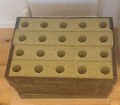Edible wall
This page is under construction!
Objectives and context
Motivation: upgrading a multi-functional “living wall”
Our general motivation is to produce food on-site, while valorising excreta (human waste) and combining several advantages.
In this project, our mission is to upgrade existing “living walls” to combine several functions and characteristics:
- Grow edible plants (or medicinal, scented… instead of just decorative exotic plants)
- Fertilise the plants with human source-separated urine only (and avoid using any chemical fertiliser)
- Purify indoor air, which passes through the soil and root system
- Use material that is renewable, locally available, … (as far as possible)
- Have a beautiful planted wall, that increases well-being in offices, inside buildings, or in the city
Our priority is to valorise human ‘’’urine’’’ to grow ‘’’edible plants’’’. Yerk?! Yes, you read it correctly. And you should get convinced of the many advantages of the reuse of urine for agriculture by reading a coming page…
System description and constraints
Soil substitute
The vertical “modules” consists of pannels of a kind of foam. (Currently it’s rock wool, but we want to change this to another renewable material with similar properties). The plants are planted in holes, and their roots then develop through this “matrix” and at the back of the panels. Specificity: very little real natural soil, lightweight.
‘’’Fertigation (= irrigation + fertilisation)’’’
Drip irrigation, with a nutritive solution made of tap water and currently a chemical fertiliser, which we’ll replace by urine. The solution is recirculated in the wall. Similarly to a hydroponic system, the solution must contain all nutrients needed by the plants, in a readily available form, and in the appropriate concentration for continuous fertigation (as opposed to ponctual fertilisation).
This means that the nutrients concentration shouldn’t be too high, because 1. Too high an ammonium concentration is toxic to plant [refs] 2. Excessive fertilisation also causes damages, such as nitrates accumulating in leaves [refs].
ADD 1-2 PICTURES
‘’’Plants for vertical indoor garden’’’ […]
Specific objectives
‘’’Specific challenge for urine fertigation’’’‘ [why we have these questions] [Why dilute: odour for indoor, toxicity of ammonium, damage if excess nutrients - ] Obviously we want to avoid odours, especially because this version of living walls is designed for inside buildings. But we also need to find the ideal urine dilution also to avoid excessive nutrients (see just above) and the toxicity of ammonium. [Why we need to make sure that urine gets nitfrifyied in the panels!] Most plants prefer nitrate-nitrogen to ammonia-nitrogen as a nitrogen source, and these plants are easily damaged by excessive ammonium nutrition. (Shinohara et al, 2008) [enter ref] This is why most hydroponic solutions contain nitrates, not ammonium [ref needed]. However stored urine contains nitrogen in the form of ammonium, which must therefore be converted to nitrate. This requires the presence of nitrifying bacteria, and sufficient oxygenation. It is generally the case in soil… but how about in our living walls, in soil substitue? Is it a suitable medium to host active nitryfiers? For this reason, we first want to answer the following questions. <!—Should we could explain more? Or in the respective sections? E.g. * Importance of aeration = of how panels are covered --> ‘’’Questions for experiments’’’
- ‘’’Nitrification in modules’’’ - Does nitrification of urine take place in our soil substitutes? Is it quick enough? How it it influenced by the following factors?
- ‘Inoculation’ (none / with nitrifying solution)
- ‘Dilution factor’ (between 1:10-1:50)
- ‘aeration properties’ of the panels (free surface / covered with a plastic sheet / active aeration)?
- ‘Different soils’ (none? / special for germination, sterilised / garden compost / field, without chemicals?)
- What is the ideal ‘’’dilution rate’’’?
- Limit to prevent odours
- Appropriate dilution to reach at least the same performance as the chemical solution (or compare between dilutions)
- How do ‘’’different edible plants’’’ grow under these conditions? Which are the most adapted?
People involved
’’Main actors’’: Michka and Alexandra ‘’’ Participants’’’ (have helped us so far):
- at Hackuarium: Clément, … and of course Yann & Yann
- Colleagues at ESTEE: Saida, Théodore, Tomas
‘’’External partners’’’: We cooperate with the enterprises link Biotecture and link Living Green City UK. They produce and install living wall inside and outside buildings. Biotecture have provided us with the core of the modules and share some know-how. The team at Living Green City UK, in London, currently focus on air filtration function. We are in contact with them, to ensure the integration of the different functions. Friends and ‘’’related projects’’’: Vertical / urban farming, aquapony, and such species: Vertikal farms, Exodes Urbains, others met Links Communication: Slack channel: #wg-edible-wall
